Optimizing Bell Times: A Consequential System Design Choice
How Bell Times Affect Efficiency
School systems can significantly improve the efficiency of a student transportation system by aligning and spacing bell times and balancing trips to maximize the use of each vehicle. Optimizing bell times has four steps:
- Align bell times neatly in well-defined tiers.
- Space bell times out to allow trips to run longer, cover more ground, and serve more students.
- Balance bell times across service tiers to maximize the number of schools that one vehicle and one driver can serve.
- Pair trip options to maximize the use of vehicles and drivers and simplify communication to families.
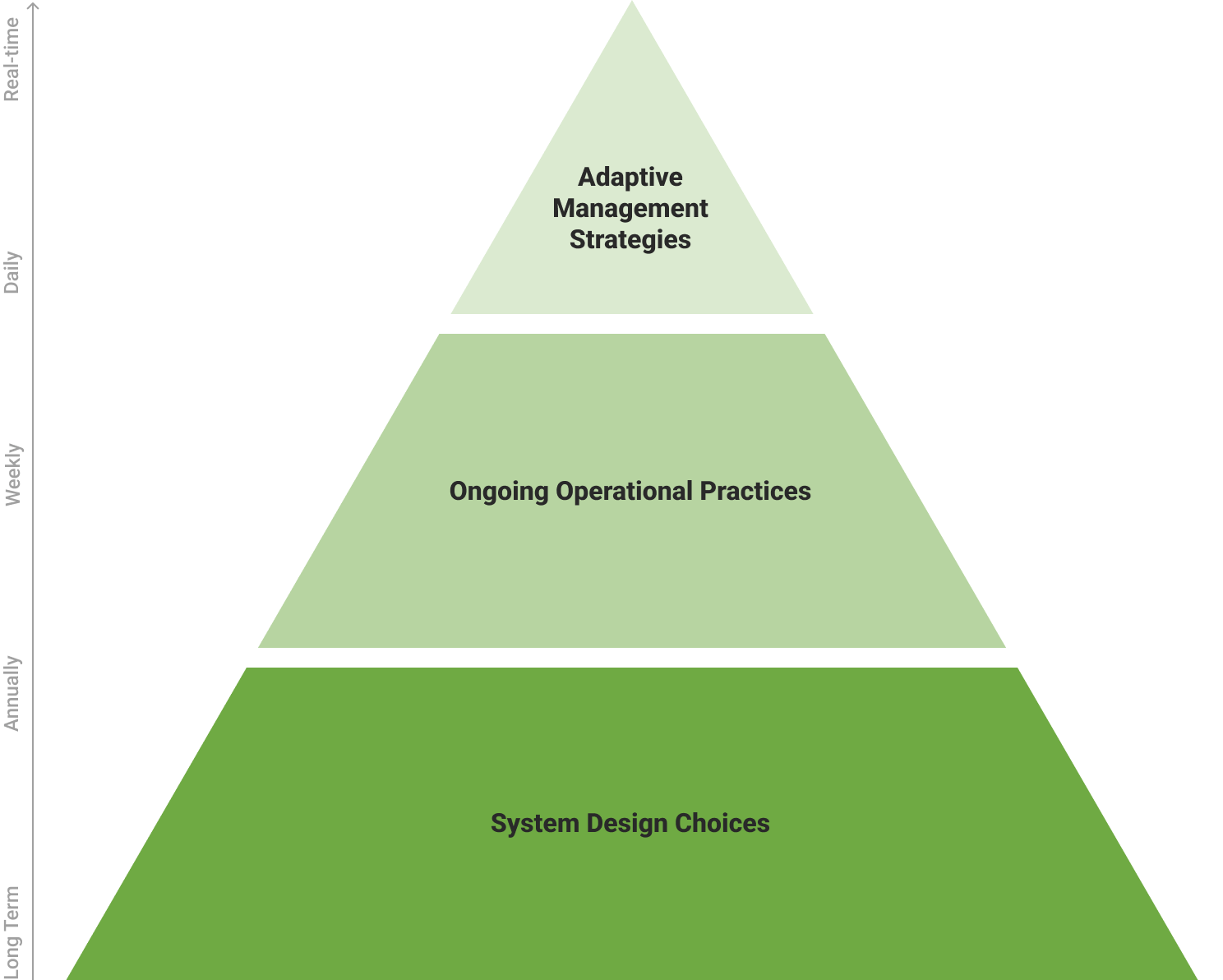
A Consequential System Design Choice
4MATIV’s efficiency framework summarizes crucial system design choices and levers for containing costs and driving efficiencies. The efficiency framework outlines three broad categories that impact the efficiency and effectiveness of a transportation system: system design choices, ongoing operational practices, and adaptive management strategies. At the bottom of the efficiency pyramid are system design choices: the long-held, hard-fought system decisions that are reviewed and revised every few years. Policy changes at this level have the largest impact. Efforts here can create significant efficiencies and cost savings because they reorganize the actual movement of buses and students.
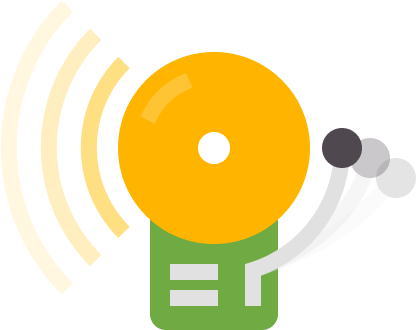
How to Modify Bell Times
The primary goal of balancing and aligning bell times from the standpoint of student mobility is to reduce the number of vehicles and drivers required to transport students. The amount of efficiency to be gained is determined by how imbalanced the current service tiers are, how aligned individual school schedules are on those tiers, and how service tiers are spaced. In order to optimize bell times, a school system needs to align, space, balance, and pair:
- Align bell times within service tiers to maximize alignment of trips within tiers. It is not sufficient to simply assign bell times by tier (e.g., bell times between 7:30–8:30 a.m. are in Tier 1). Bell times must be aligned within a tight time period, typically a 10-minute window. For instance, a system with two service tiers may have bell times between 7:30–7:40 a.m. for Tier 1 and between 8:30–8:40 a.m. for Tier 2. From an operational standpoint, trips in the first tier can arrive earlier than the Tier 1 target time, but not later. Similarly, trips in the latest tier can arrive after the target time, but not earlier, to achieve functional alignment within the tiered structure.
- Space tiers adequately to allow for the completion of trips. In addition to aligning school bell times within a tight time range by tier, the school system must ensure there is sufficient spacing between bell time tiers so that trips and deadhead travel can be completed. Examining average trip times and the proportion of current trips plus deadhead that are completed within the planned tier interval can inform spacing decisions. For instance, if 75 percent of trips plus deadhead can be completed in 60 minutes, the school system should aim for a tier spacing of an hour (e.g., 7:30 a.m., 8:30 a.m., 9:30 a.m.), knowing that a quarter of trips will need to be shortened. Larger tier intervals enable the inclusion of conservative deadhead (more than 10 minutes), which typically facilitates easier trip pairing, enhanced on-time performance, more resilience to traffic or weather events, increased driver satisfaction, and enhanced safety outcomes.
- Balance school bell times across service tiers to create even service demands across service tiers according to the number of trips required. When balancing trips, the focus should be on the number of trips required in order to transport students for each tier. Because vehicle demands vary significantly from one school to another, balancing should not be done by the number of schools per tier. For instance, one school may require 20 buses whereas another may require 2 buses.
- Pair trips to maximize trip utilization for each vehicle. A maximally utilized vehicle and driver should do as many round trips daily as there are bell tiers in a tiered system. School systems should design routes with a minimum 10-minute deadhead when pairing trips. In the first morning service tier, a larger dropoff window will enable greater flexibility and produce slack, which will facilitate more pairing options and could accommodate longer trip duration in the subsequent tier. For example, if a school with a 7:30 a.m. bell time accepts students at 7:00 a.m., the driver has 90 minutes before the Tier 2 bell at 8:30 a.m. to complete the next trip.

Example Configurations
Two Tiers with Perfect Alignment and Perfect Pairing
A two-tier bell time configuration enables a longer interval between bell times as seen in the visual below in which there is 75 minutes between the Tier 1 bell time of 7:45 a.m. and the Tier 2 bell time of 9:00 a.m. Generally, it is easier to keep bell times within the narrower range of preferred times, avoiding very early or very late bell times.
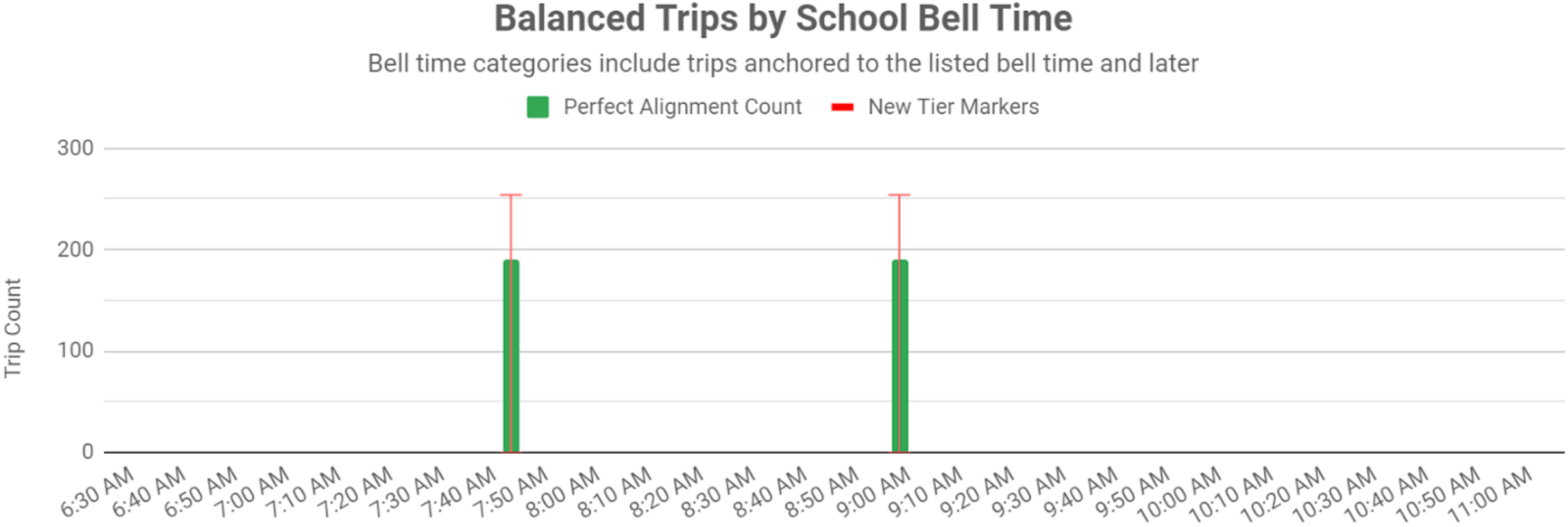
Three Tiers with Perfect Alignment and Perfect Pairing
A three-tier system typically requires greater spread of bell times as seen in the visual below in which bell times are at 7:30 a.m., 8:30 a.m., and 9:30 a.m. This spread is necessary to ensure solid performance in the later service tiers and sufficient time to pick up and drop off students while achieving decent seat utilization.
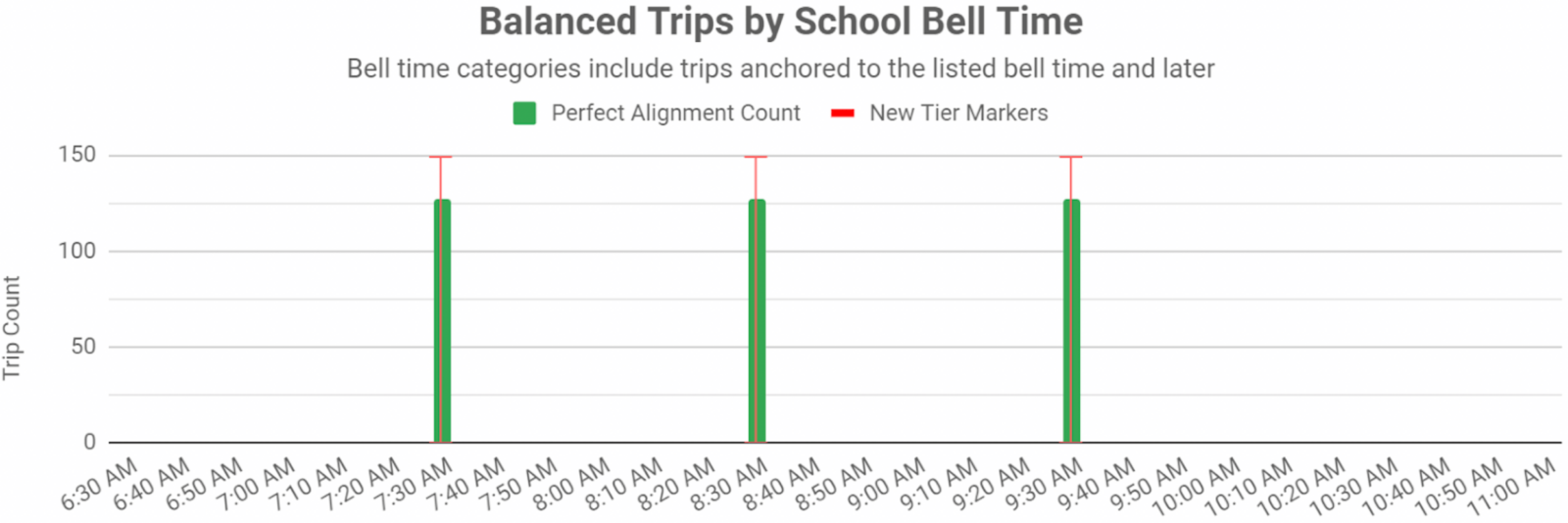
Two Tiers with Eased Alignment and Perfect Pairing
Because of the larger interval between bell times that is feasible with a two-tier system, it is possible to have considerably eased alignment of bell times on the front-end of the first tier and the back-end of the second tier, as depicted below. While this is also true in a three-tier system, practically, eased alignment is constrained by driver workday limits. And in a three-tier system, the middle tier must have tight alignment to ensure sufficient pairing options on both sides of the trip.
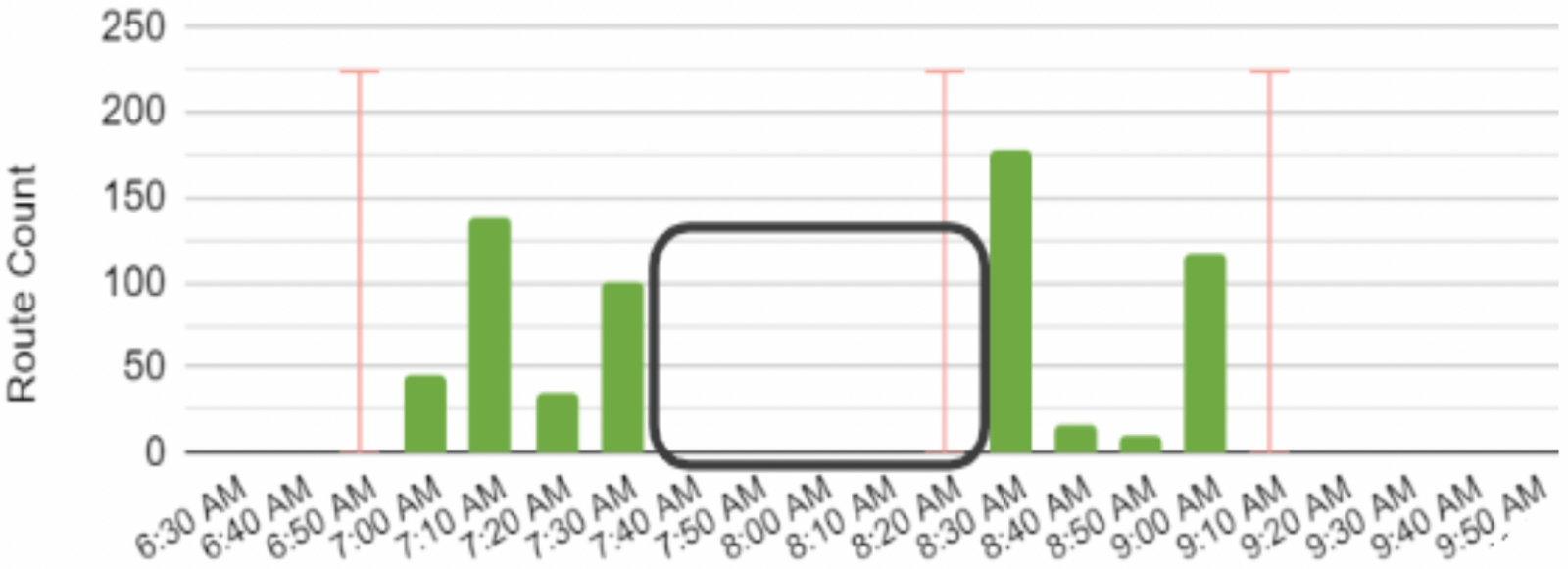

Assessing Options
- There is not a definitive “correct” configuration. Each configuration has benefits and tradeoffs. A school system must determine the approach that is best for their community and what interventions the district is willing to pursue in order to achieve potential benefits. Strong implementation will determine success.
- Systems should consider crucial contextual information when making a decision, including family, staff, and student preferences as well as implications for extracurricular activities, sleep, work schedules, childcare, and so forth.
- Schools must engage local stakeholders early and often to understand their preferences, how they perceive tradeoffs and benefits, and what supports should accompany bell time changes, such as providing more wrap-around care or adjusting extracurricular scheduling.
- Preferences within a school community often vary as much as between school communities. Set expectations—for families and for transportation planners—that it will not be possible to satisfy every stakeholder.
- At minimum, develop a two-tier system. Under a two-tier system, districts can strategically pursue targeted interventions rather than across-the-board aggressive changes. A two-tier system also tends to provide the best conditions for achieving consistently high on-time performance. While two-tier systems offer less savings from vehicle reduction than an optimally-designed three-tier system, they do allow more ability to enhance seat utilization by lengthening trips without aggressive interventions (such as stop consolidation, mode shifting, and changing eligibility rules) if tiers are spaced further apart and are more flexible on bell time alignment within each tier.
- Consider a three-tier system that would offer the largest theoretical opportunity for savings and vehicle reduction as each vehicle and driver can serve three schools each day—and up to 200 students on a full-size bus if all seats are occupied. More bell times exist within a three-tier system, which creates more operational complexity but also more choice for families and school-based staff to find a bell time that works best for their schedule. However, a three-tier system typically requires significant route shortening, and therefore multiple other interventions (such as mode shifting and aggressive stop consolidation) to realize the full benefits. Bell times also generally must be perfectly aligned within a three-tier configuration in order to provide sufficient pairing options. Finally, a three-tier system is also the hardest to pull off operationally, as performance tends to degrade across tiers.

Two Tier System:
Benefits and Challenges
Benefits
- Best conditions for on-time performance
- Potential for higher vehicle utilization
- Easier trip pairing options
- Typically higher driver satisfaction
- Accommodates varied day lengths due to larger tier interval
- Ability to ease alignment within tier
Challenges
- Reduces bell time choices
- Typically greater magnitude of bell time changes for more schools
- Diminished potential savings from vehicle reduction
- May be more challenging to convince nonpublic schools to align bell times
Three Tier System:
Benefits and Challenges
Benefits
- Provides more bell time choices for families and school staff members
- Smaller magnitude of bell change typically required for more schools
- Greater bus reductions possible with perfect alignment and perfect pairing
Challenges
- Often requires significant route shortening
- Often requires stop consolidation and service level adjustments
- More complex and limited trip pairing
- Degraded performance in third tier
- Requires some undesirable (late/early) bell times
- Close to contractual maximum workday
- Varied day lengths are more difficult to accommodate
